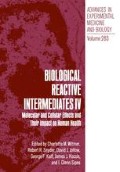Abstract
Acetaminophen (N-acetyl-p-aminophenol, APAP), one of the most widely used analgesic, antipyretic drugs currently available, when taken in excess of therapeutic doses can be activated by cytochrome P-450 to a highly reactive metabolite, Nacetylbenzoquinoneimine (NAPQI) (Dahlin, et al., 1984). NAPQI has been characterized as a strong electrophile and a potent oxidizing agent (Blair, et al., 1980) and both properties can lead to adverse effects on cellular metabolism (Albano, et al., 1985; Porubek, et al., 1987; Birge, et al., 1988). In order to more effectively evaluate the mechanisms of action of APAP and their physiological consequences, it becomes crucial not only to identify the early metabolic events that are altered, but also whether the functional impairments can be restored or have become irreversible.
Access this chapter
Tax calculation will be finalised at checkout
Purchases are for personal use only
Preview
Unable to display preview. Download preview PDF.
References
Albano, E., Rundgren, M., Harvison, P.J., Nelson, S.D. and Moldeus, P. (1985). Mechanism of N-acetyl-p-benzoquinone imine cytotoxicity. Mol. Pharmacol. 28, 306–311.
Beales, D., Hue, D.P. and McLean, A.E.M. (1985). Lipid peroxidation, protein synthesis, and protection by calcium EDTA in paracetamol injury to isolated hepatocytes. Biochem. Pharmacol. 34, 19–23.
Birge, R.B., Bartolone, J.B., Nishanian, E.V., Bruno, M.K., Mangold, J.B., Cohen, S.D. and Khairallah, E.A. (1988). Dissociation of covalent binding from the oxidative effects of acetaminophen: studies using dimethylated acetaminophen derivatives. Biochem. Pharmacol. 37, 3383–3393.
Birge, R.B., Bartolone, J.B., McCann, D.J., Mangold, J.B., Cohen, S.D. and Khairallah, E.A. (1989). Selective protein arylation by acetaminophen and 2,6-dimethyl-acetaminophen in cultured hepatocytes from phenobarbital-induced and uninduced mice. Biochem. Pharmacol. 38, 4429–4438.
Blair, I.A., Boobis, A.R., Davies, D.S., and Cresp, T.M. (1980). Paracetamol oxidation: Synthesis and reacivity of N-acetyl-p-benzoquinoneimine. Tetrahedron Lett. 21, 4947–4950.
Bruno, M.K., Bartolone, J.B., Cohen, S.D. and Khairallah, E.A. (1985). Cultured mouse hepatocytes as a valid model for acetaminophen hepatotoxicity. Pharmacologist 27, 482.
Bruno, M.K., Cohen, S.D. and Khairallah, E.A. (1986). Perturbations in protein metabolism induced by acetaminophen are not the result of GSH depletion. Fedn. Proc. 45, 1932.
Bruno, M.K., Cohen, S.D. and Khairallah, E.A. (1988). Antidotal effectiveness of N-acetylcysteine in reversing acetaminophen-induced hepatotoxicity. Enhancement of the proteolysis of arylated proteins. Biochem. Pharamcol. 37, 4319–4325.
Dahlin, D.C., Miwa, G.T., Lu, A.Y. and Nelson, S.D. (1984). N-Acetyl-p-benzoquinone imine: a cytochrome P-450-mediated oxidation product of acetaminophen. Proc. Natl. Acad. Sci. USA 81, 1327–1331.
Fernando, C.R., Calder, I.C. and Ham, K.N. (1980). Studies on the mechanism of toxicity of acetaminophen. Synthesis and reactions of N-acety1–2,6-dimethyl-and N-acety1–3,5-dimethyl-p-benzoquinone imines. J. Med. Chem. 23, 1153–1158.
Gwynn, J., Fry, J.R. and Bridges, J.W. (1979). The effect of paracetamol and other foreign compounds on protein synthesis in isolated adult rat hepatocytes. Biochem. Soc. Trans. 7, 117–119.
Laemmli, U.K. (1970). Cleavage of structural proteins during the assembly of the head bacteriophage T4. Nature 227, 680–685.
Porubek, D.J., Rundgren, M., Harvison, P.J., Nelson, S.D. and Moldeus, P. (1987). Investigation of the mechanism of acetaminophen toxicity in isolated hepatocytes with the acetaminophen analogues 3,5-dimethylacetaminophen and 2,6-dimethylacetaminophen. Mot. Pharmacol. 31, 647–653.
Thorgeirsson, S.S., Sesame, H.A., Mitchell, J.R., Jollow, D.J. and Potter, W.Z. (1976). Biochemical changes after hepatic injury from toxic doses of acetaminophen or furose m ide. Pharmacology 14, 205–217.
Author information
Authors and Affiliations
Editor information
Editors and Affiliations
Rights and permissions
Copyright information
© 1991 Plenum Press, New York
About this chapter
Cite this chapter
Bruno, M.K., Cohen, S.D., Khairallah, E.A. (1991). Selective Alterations in the Profiles of Newly Synthesized Proteins by Acetaminophen (APAP) and its Dimethylated Analogues: Relationship to Oxidative Stress. In: Witmer, C.M., Snyder, R.R., Jollow, D.J., Kalf, G.F., Kocsis, J.J., Sipes, I.G. (eds) Biological Reactive Intermediates IV. Advances in Experimental Medicine and Biology, vol 283. Springer, Boston, MA. https://doi.org/10.1007/978-1-4684-5877-0_27
Download citation
DOI: https://doi.org/10.1007/978-1-4684-5877-0_27
Publisher Name: Springer, Boston, MA
Print ISBN: 978-1-4684-5879-4
Online ISBN: 978-1-4684-5877-0
eBook Packages: Springer Book Archive

